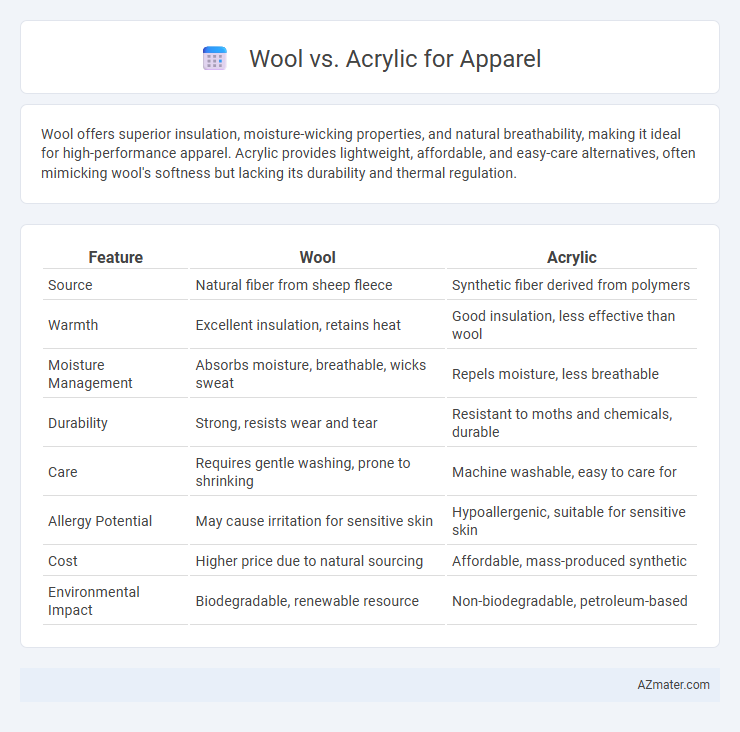Wool offers superior insulation, moisture-wicking properties, and natural breathability, making it ideal for high-performance apparel. Acrylic provides lightweight, affordable, and easy-care alternatives, often mimicking wool's softness but lacking its durability and thermal regulation.
Table of Comparison
| Feature | Wool | Acrylic |
|---|---|---|
| Source | Natural fiber from sheep fleece | Synthetic fiber derived from polymers |
| Warmth | Excellent insulation, retains heat | Good insulation, less effective than wool |
| Moisture Management | Absorbs moisture, breathable, wicks sweat | Repels moisture, less breathable |
| Durability | Strong, resists wear and tear | Resistant to moths and chemicals, durable |
| Care | Requires gentle washing, prone to shrinking | Machine washable, easy to care for |
| Allergy Potential | May cause irritation for sensitive skin | Hypoallergenic, suitable for sensitive skin |
| Cost | Higher price due to natural sourcing | Affordable, mass-produced synthetic |
| Environmental Impact | Biodegradable, renewable resource | Non-biodegradable, petroleum-based |
Introduction to Wool and Acrylic Fibers
Wool fibers originate from the fleece of sheep, offering superior insulation, moisture-wicking properties, and natural breathability ideal for apparel designed for cold and variable climates. Acrylic fibers are synthetic polymers engineered to mimic the softness and warmth of wool while providing greater resistance to moths, mildew, and shrinkage, making them a cost-effective alternative in garment manufacturing. Understanding the intrinsic properties of wool's natural protein-based composition versus acrylic's petroleum-derived structure is essential for selecting fabrics tailored to specific apparel performance and care requirements.
Wool vs Acrylic: Origins and Production
Wool, derived from sheep fleece, is a natural fiber historically sourced from breeds like Merino, prized for its moisture-wicking and insulating properties. Acrylic, a synthetic fiber produced through polymerization of acrylonitrile, offers durability and resistance to moth damage while mimicking wool's softness at a lower cost. The production of wool involves shearing, cleaning, and carding, whereas acrylic undergoes chemical synthesis and extrusion, making it more scalable and less resource-intensive compared to livestock farming.
Comfort and Wearability Compared
Wool offers superior breathability and moisture-wicking properties, making it highly comfortable for extended wear by regulating body temperature and reducing sweat accumulation. Acrylic fibers provide a softer and lighter feel but lack the natural insulation and odor resistance of wool, often resulting in less comfort during prolonged use. Wool's durability and elasticity also enhance wearability, maintaining shape and comfort over time compared to acrylic's tendency to pill and lose loft.
Warmth and Insulation Properties
Wool provides superior warmth and insulation due to its natural crimped fibers that trap air, offering excellent thermal regulation and moisture-wicking capabilities. Acrylic, a synthetic fiber, mimics wool's softness and warmth but generally falls short in breathability and moisture management, leading to less effective insulation in varying conditions. For cold-weather apparel, wool remains the preferred choice for maximum warmth and comfort.
Moisture Management and Breathability
Wool excels in moisture management by naturally wicking sweat away from the skin and allowing it to evaporate, keeping the wearer dry and comfortable during physical activity. Its breathable fibers regulate temperature effectively, preventing overheating and maintaining airflow. Acrylic, while lightweight and warm, lacks the same moisture-wicking capability and breathability, often trapping sweat and reducing overall comfort in active wear.
Durability and Longevity in Clothing
Wool offers exceptional durability and longevity in apparel due to its natural resilience, moisture-wicking properties, and ability to retain shape over time, making it ideal for garments subjected to frequent wear. Acrylic fibers, while lightweight and resistant to moths and mildew, tend to pill and degrade faster under repeated stress and washing, reducing their lifespan compared to wool. Choosing wool ensures longer-lasting clothing with sustained performance, especially in outerwear and knitwear applications.
Care and Maintenance Requirements
Wool requires gentle care, including hand washing in cold water and air drying to maintain its natural fibers and prevent shrinking or felting. Acrylic is more durable and machine washable, offering easier maintenance with quick drying and resistance to moths and wrinkles. Proper storage for wool, such as using moth repellents and avoiding moisture, is essential to preserve its quality over time.
Sustainability and Environmental Impact
Wool is a natural, biodegradable fiber that supports sustainable farming practices and reduces reliance on synthetic materials, making it an eco-friendly choice for apparel. In contrast, acrylic fibers are petroleum-based, non-biodegradable, and contribute to microplastic pollution, posing significant environmental challenges during production and disposal. While wool requires water and land resources for livestock, its renewable nature and carbon sequestration potential make it a more sustainable option compared to acrylic's fossil fuel dependency and lengthy degradation process.
Allergies and Skin Sensitivity: Wool vs Acrylic
Wool often triggers allergic reactions or skin irritation due to lanolin and coarse fibers, making it less suitable for sensitive skin. Acrylic, a synthetic fiber, is hypoallergenic and generally gentler, reducing the risk of itching and rashes. Choosing acrylic can enhance comfort for those prone to allergies or dermatitis while maintaining warmth and durability.
Cost Analysis and Value for Money
Wool generally costs more than acrylic due to its natural origin, durability, and superior insulation properties, making it a premium option for apparel. Acrylic offers a budget-friendly alternative with lower upfront costs but may lack the longevity and breathability of wool, potentially leading to more frequent replacements. Evaluating value for money depends on prioritizing long-term durability and comfort in wool versus the affordability and ease of care provided by acrylic fibers.

Infographic: Wool vs Acrylic for Apparel
 azmater.com
azmater.com